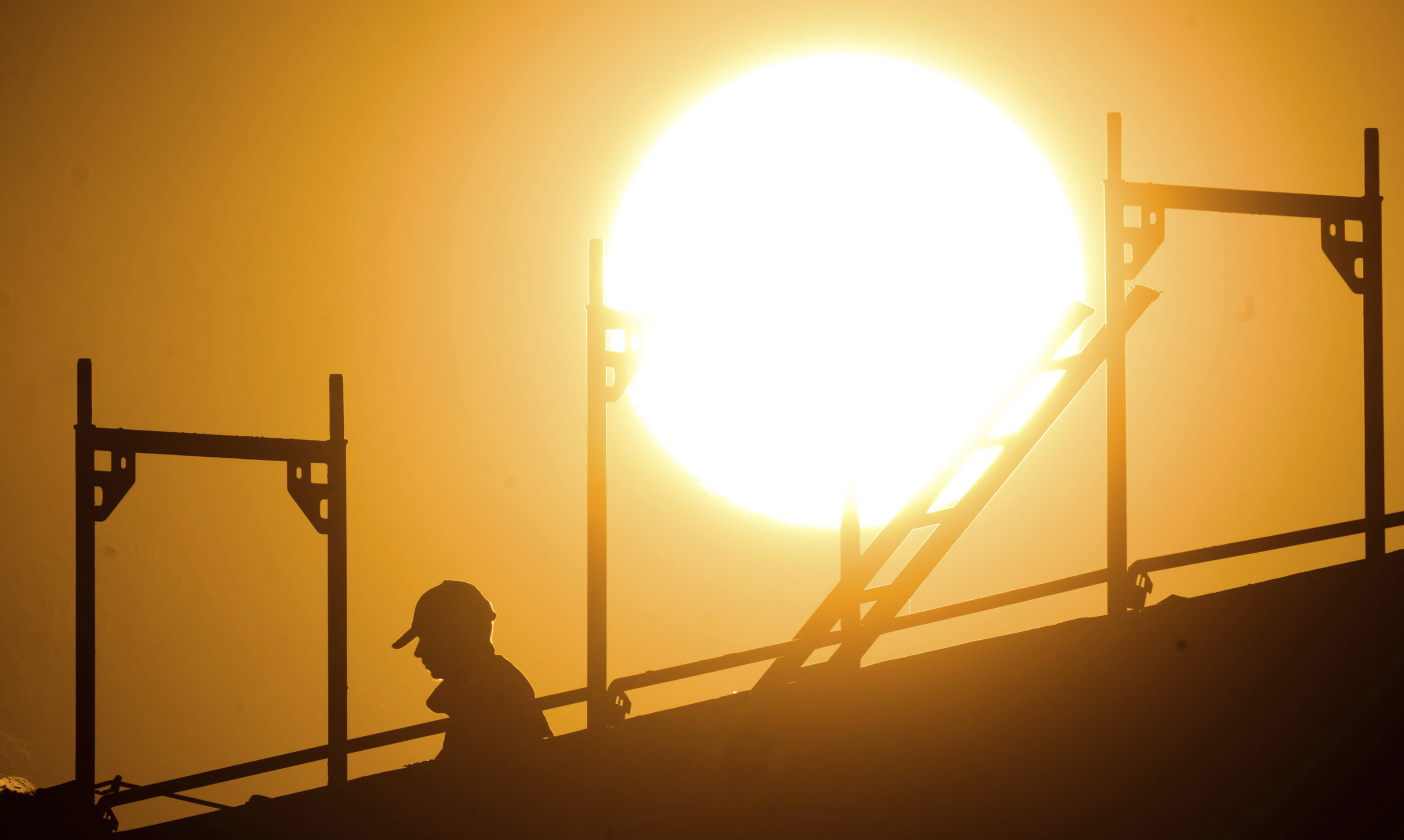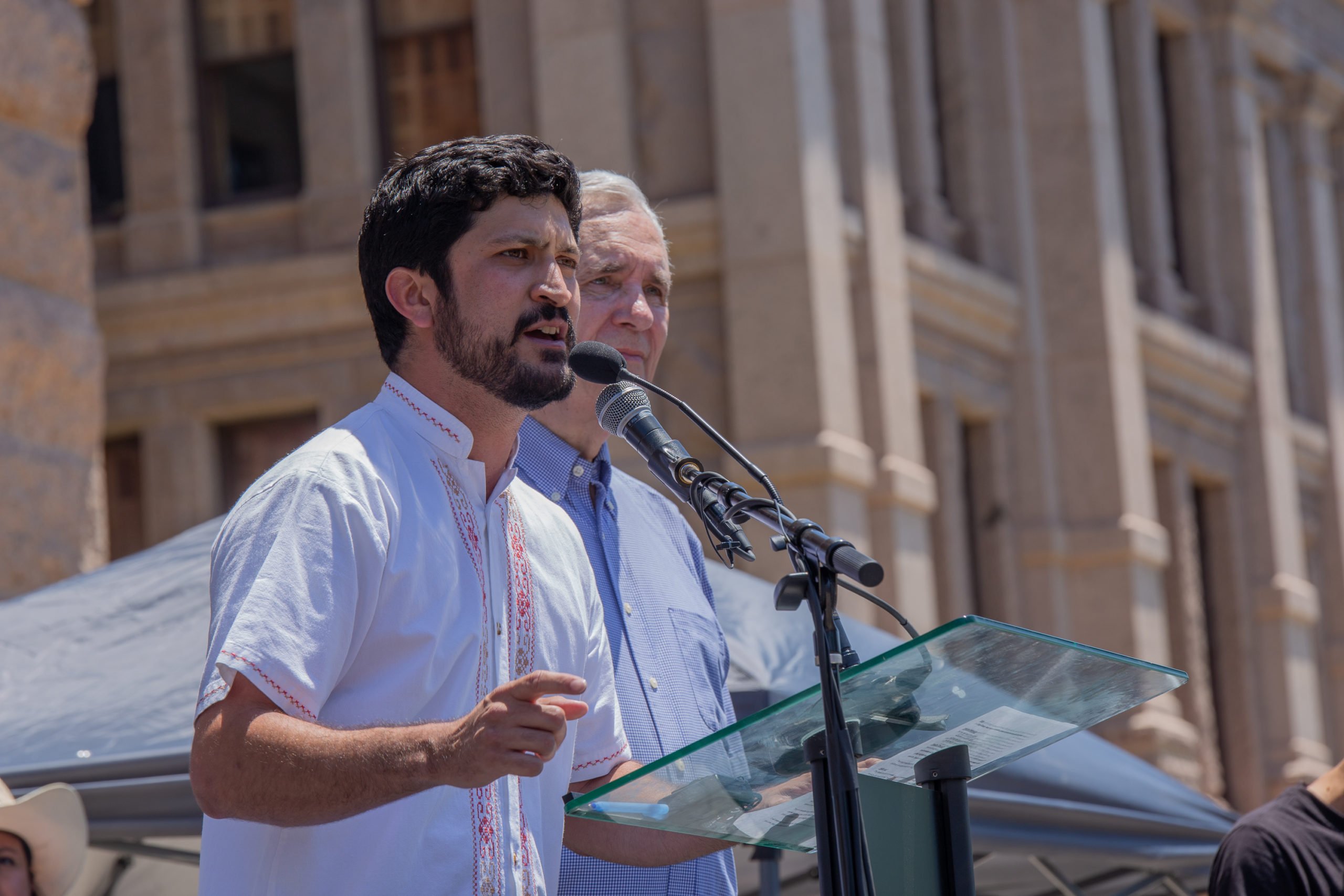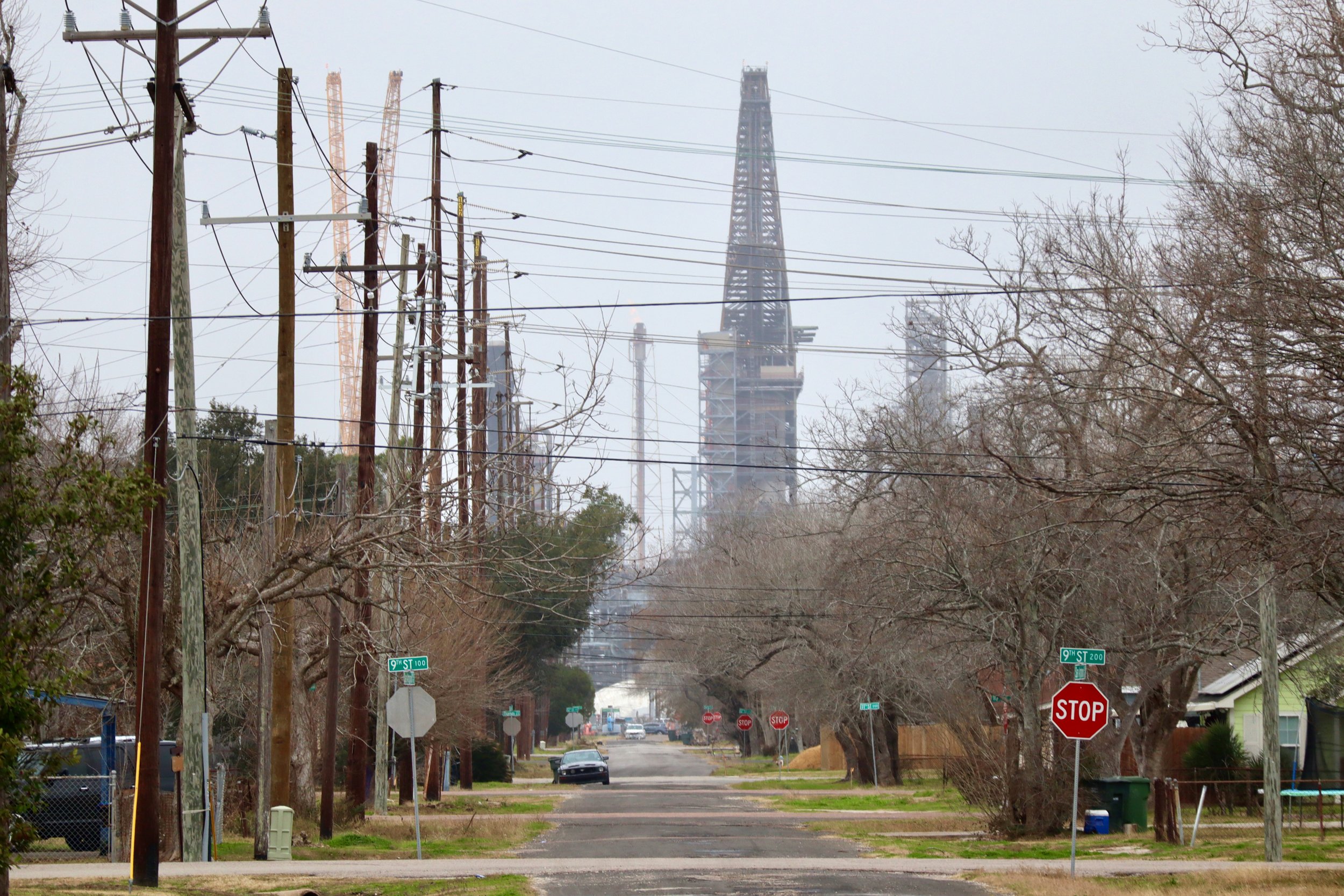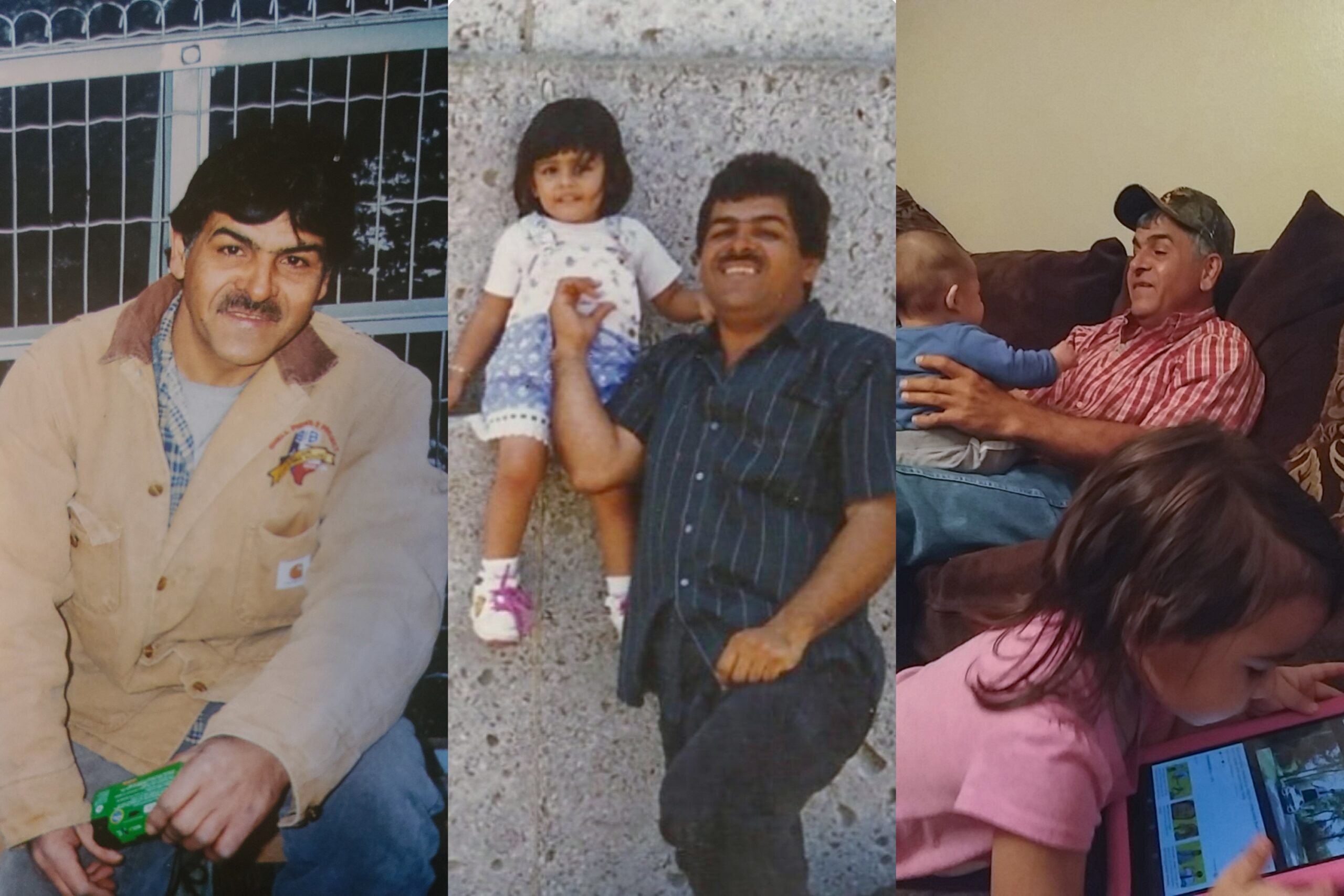
Texas Workers, Congressman Launch ‘Thirst Strike’ for Heat Protections
“My brother would still be here if he just had a water break,” said Jasmine Granillo, who’s joining the call for OSHA to save workers from the Texas Legislature.

Editor’s Note, August 3 2023: Michelle Pitcher looked at the President Biden’s response to the thirst strike in this update.
Jasmine Granillo was 11 years old when her family joined other workers in a “thirst strike”—a protest in which participants decline to drink water—on the steps of Dallas City Hall in 2015. For a full day, Jasmine’s father Gustavo Granillo went thirsty to draw attention to the death of his 25-year-old son Roendy Granillo and pressure the city to pass a water break mandate to protect construction workers from heat illnesses. Roendy had died three months earlier from heat stroke after reportedly being denied a break at a residential construction job. After the action, Jasmine and her family continued their activism with the worker rights organization Workers Defense Project, protesting and speaking to city council members. By the end of the year, Dallas passed an ordinance mandating that construction laborers receive a 10-minute rest break every four hours, a policy similar to one passed by Austin five years prior.
Now eight years later, Jasmine and her family will join other workers, labor unions, and elected officials in a day-long thirst strike Tuesday on the steps of the U.S. Capitol in Washington, D.C., to call on President Joe Biden to rapidly implement a federal Occupational Safety and Health Administration (OSHA) heat protection standard, which would effectively trump Texas Governor Greg Abbott’s decision to ban local water break ordinances like the one in Dallas. House Bill 2127, the so-called Death Star bill which bans the rest break ordinances, goes into effect September 1 of this year. Currently, Texas is withering under record-breaking summer heat; already, a Dallas mail carrier, a Houston construction worker, and a utility lineman from East Texas have died from the extreme temperatures.
“It’s a basic human right for every worker to get a water break when they need to. It saves their lives. My brother would still be here if he just had a water break. It’s that simple,” Jasmine told the Observer.
The thirst strike on Capitol Hill will be led by Congressman and Whip of the Progressive Caucus Greg Casar, an Austin Democrat who yesterday released a letter signed by more than 100 U.S. House members and Senators urging the Biden administration to accelerate the work of establishing a federal OSHA standard to prevent heat-related work injuries and illnesses—a process that is underway but may be years from completion. Specifically, the letter calls for the standard to require employers to provide workers with adequate hydration, rest breaks, cooling areas for breaks, medical services, and training to identify signs of heat-related illness. At present, OSHA does not specifically require rest breaks; neither does Texas law.
“It’s up to people of conscience in the federal government to step up and intervene,” Casar told the Observer. “President Biden has the opportunity to protect workers and to save lives.”

Casar was 21 in the summer of 2010 when he first organized a thirst strike to push the Austin City Council to mandate water breaks. Working as a community organizer and later the policy director for the Workers Defense Project, Casar had gone from one construction site to another in Austin, listening to workers who revealed they were unable to come down from scaffolding, working long hours under the scorching heat. The workers’ efforts to mandate breaks faced resistance from corporate lobbyists such as the Associated Builders and Contractors. Casar knew he couldn’t just patiently wait on legislators to take action.
“I believe in inside-outside organizing. That means organizing those folks with power on the inside, but also supporting grassroots organizing on the outside,” Casar said. “These thirst strikes were so critical for getting this work done in Texas. And I thought it made a lot of sense for us to come full circle and do the same thing now that I’m in Congress.”
During her interview with the Observer, Jasmine recalled how her brother Roendy acted as a father figure to her and her two other siblings, while their father worked long hours in construction. Roendy took the family out to play, started a reward system for the siblings to keep up their grades in school, and coached Jasmine on what to expect entering middle school.
One Sunday in July 2015, Roendy left for work at 7 a.m. and promised to return at 3 p.m. to take the family to the flea market. The temperature hit 97 degrees as he laid down hardwood floors at a residential job site. But Roendy’s father said the manager refused Roendy a water break, and he got sicker as the day continued. Jasmine and her family waited for him until they received a call at 8 p.m. A coworker told the family Roendy was at the hospital. But by the time his mom arrived, doctors had already pronounced Roendy dead. His body temperature had reached 110 degrees, and his organs had failed.
“I didn’t understand everything at the time, or how beneficial the water break mandate would be. I just knew that I was doing this for my brother. Now that I’m a lot older, I realize how much this law has protected workers from the heat,” Jasmine, now 19 years old, said.
A study by the consumer advocacy organization Public Citizen, using data from the Bureau of Labor Statistics and the Centers for Disease Control and Prevention, estimated that 170,000 work-related injuries and 700 deaths happen every year around the country as a result of working in high heat. Prolonged exposure to heat can result in nausea, dizziness, and fainting, which when left untreated can lead to death from a breakdown of the kidneys and other organs. A heat safety standard in California’s state OSHA plan may have resulted in a 30 percent reduction in heat-related workers injuries, and based on those figures, Public Citizen estimated that a national standard would prevent more than 50,000 heat-related injuries and illnesses a year.
Dallas construction worker Marisol Gayosso told the Observer it takes her exactly eight to ten minutes drinking water and sitting in the shade for her body to recover from the fatigue and dizziness she feels after working several hours in the heat. Even with a water break, she still sometimes gets headaches and vomits.
“Now that HB 2127 is law, imagine what that means for Texas construction workers who won’t even have these basic protections,” Gayosso said. According to data from the Bureau of Labor Statistics, Texas leads other states in construction worker fatalities. In 2021, a Texas construction laborer perished on the job every 3 days .
Gayosso said she’s traveling from Texas to Washington D.C. to join the thirst strike to “put a name and a face to what workers in Texas are experiencing.”
The push for a federal OSHA heat protection mandate is not new. Fifty years ago, the National Institute for Occupational Safety and Health (NIOSH) urged rules to protect workers from unsafe heat. Still, OSHA has no such rule in place. When the agency does (rarely) engage in heat-related enforcement, it relies on a broad “general duty clause” that leaves its fines and sanctions vulnerable to legal challenges from employers. In the past, administrative law judges have tossed out five of the agency’s heat enforcement actions, which centered on United States Postal Service (USPS) workers who were exposed to excessive heat delivering mail. This June, Dallas USPS mail carrier Eugene Gates died after he collapsed on his mail delivery route. The heat index was above 110 degrees.
“If I can give as much as my brother did, then that’s all I need.”
Homer Hernandez, a USPS mail carrier for the past two decades and legislative chair of the San Antonio branch of the National Association of Letter Carriers, decried Gates’ death as preventable. Hernandez told the Observer that his mail truck, like many others, has no air-conditioning, only a four-by-four-inch box fan. A month ago, USPS stopped providing bottled water to its workers, he said. In past years, after delivering mail for four hours, he started to feel drowsy and get stomach pangs. This year, he feels the same effects in less than three hours. Members of his union are joining the thirst strike to demand “OSHA update their policies. They are not up to par anymore,” Hernandez said. With climate change, he says, “It’s only getting hotter and hotter.”
In a response to the Observer, USPS Communications Specialist Becky Hernandez said USPS has implemented a national Heat Illness Prevention Program for its employees. The program mandates heat-related safety training and reminds mail carriers “to hydrate, wear appropriate clothing, including hats, get in the shade whenever possible, and to take sufficient amounts of water and ice with them out on their routes.” Hernandez added that 34 percent of all current postal vehicles have air conditioning.
In 2021, OSHA started working on a heat safety standard, but this process can take 5-8 years or even longer.
“It takes so long because of the enormous right-wing corporate lobbying power in Washington, DC. They use every trick in the book that they can to slow down the process,” Casar said. “So we need to bring national and statewide attention to this OSHA rule if we want to get something done before next summer when workers will have less rights after Abbott’s law goes into effect September 1.” (The Cities of Houston and San Antonio are suing the state in an attempt to block the law.)
Casar said discussions with OSHA Assistant Secretary Doug Parker have been promising. In an email to the Observer, Parker wrote, “Heat illness prevention is one of the OSHA’s top priorities and we’re working diligently towards developing a proposed rule to protect workers from heat illness.” Parker wrote that, in the meantime, the agency is stepping up enforcement efforts to prevent heat illnesses.
Jasmine said she’s inspired by her brother Roendy to participate in the thirst strike and continue fighting because Roendy always stood up for others and took care of their family. She’s working to save up money to get certification as a nurse, a first responder, or a radiologist so she can help save lives.
“If I can give as much as my brother did, then that’s all I need. This is easy to do after seeing the person my brother was.”



